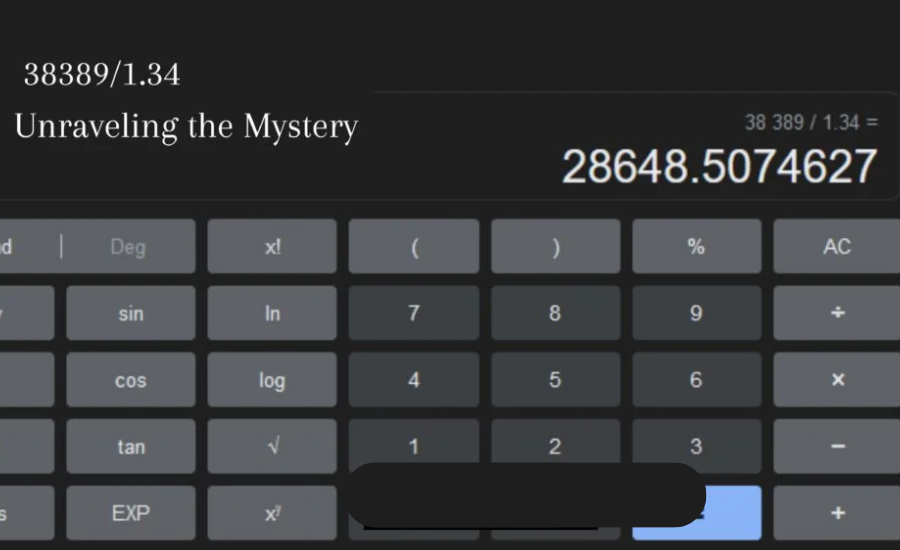Unveiling the Significance of 38389/1.34: A Comprehensive Exploration
Introduction to 38389/1.34
In today’s data-driven world, numerical sequences like 38389/1.34 might initially appear cryptic or abstract, but they possess substantial significance across various sectors. These sequences, whether encountered in financial reports, scientific studies, or technological frameworks, often hold deeper meanings that can reveal crucial insights and drive important decisions. The seemingly simple combination of numbers and symbols can, in fact, encapsulate a wealth of information that transcends its surface-level appearance.
For instance, in the financial sector, such ratios or metrics can be integral to assessing a company’s performance, helping investors and analysts make informed decisions. In scientific research, numerical sequences are used to describe measurements, ratios, or experimental results, providing clarity and precision in understanding complex phenomena. Similarly, in technology and engineering, these codes can represent essential specifications, standards, or identifiers, playing a critical role in product development and system operations.
By delving into the potential meanings and applications of sequences like 38389/1.34, we can uncover how these numbers are not just arbitrary figures but rather key elements that contribute to a deeper understanding of various fields. This article aims to explore the diverse interpretations of 38389/1.34, highlighting its relevance in different contexts and demonstrating how such seemingly obscure sequences can have practical and significant implications.
Exploring the Significance of 38389/1.34

Financial Interpretations and Implications
Understanding Financial Ratios
In finance, ratios like 38389/1.34 are pivotal for evaluating a company’s performance. Ratios are derived from financial statements and can reflect various aspects of a company’s health, such as profitability, liquidity, and solvency.
Numerator Analysis (38389)
- Revenue: If 38389 represents revenue, analyzing this figure helps gauge a company’s market performance. For instance, a higher revenue figure could indicate robust sales or successful market expansion.
- Market Capitalization: This could represent a company’s market capitalization, influencing investor perceptions and stock valuations.
- Stock Quantities: In a stock context, 38389 might denote the number of shares or units held, impacting portfolio diversification and investment strategies.
Denominator Analysis (1.34)
This is crucial for investors assessing earnings performance.
- Performance Multiples: The denominator might be a performance multiple, such as Price-to-Earnings (P/E) ratio, which helps in comparing company valuations.
- Growth Indices: A growth index of 1.34 could represent a company’s growth rate, indicating how rapidly it is expanding.
Applications in Science and Engineering
Scientific Relevance
In scientific disciplines, 38389/1.34 may denote specific measurements or standards, aiding in research and development.
Chemical Ratios
- Compound Formulation: In chemistry, ratios like 38389/1.34 could specify the proportion of substances in a compound, affecting its properties and effectiveness.
- Concentration Levels: The ratio might represent concentration levels in a solution, crucial for accurate experimental results.
Engineering Specifications
- Technical Parameters: Engineers often use numerical codes to define specifications. For example, 38389/1.34 could be a parameter for a machine component, influencing its design and functionality.
- Standards Compliance: It might also be a compliance code ensuring that components meet industry standards and quality controls.
Digital and Coding Contexts
Role in Digital Systems
In digital technology, sequences like 38389/1.34 serve various functions, including identification and encryption.
Coding and Algorithms
- Identifier: This sequence might be used as an identifier within a digital system, helping to track and manage data.
- Encryption Reference: In encryption algorithms, 38389/1.34 could be part of a key or reference number, playing a role in securing data transmissions.
Digital Signal Processing
- Sampling Rates: The ratio might relate to sampling rates in digital signal processing, affecting data quality and accuracy.
- Signal Frequencies: It could represent signal frequencies or transmission protocols, influencing how data is processed and interpreted.
Practical Applications of 38389/1.34

Industrial and Manufacturing Uses
Industry Codes and Standards
In industrial settings, 38389/1.34 might be a product code or compliance standard. Understanding these codes is vital for:
- Quality Control: Ensuring that products meet specified quality standards.
Statistical Data Analysis
Interpreting Data Ratios
In statistics, ratios like 38389/1.34 are used to analyze data, transform raw figures into meaningful insights, and support:
- Decision-Making: Providing a basis for strategic decisions based on accurate data analysis.
- Trend Analysis: Identifying trends and patterns from statistical data.
Hypothetical Scenarios

Financial Example
- Total Assets and Debt Ratio: If 38389 represents total assets and 1.34 is a debt-to-equity ratio, it could offer insights into financial stability, indicating how well a company manages its debt relative to its assets.
Chemical Example
- Molecule Count and Multiplicative Factor: If 38389 denotes molecules in a solution and 1.34 is a factor, it could provide valuable information about the solution’s concentration or chemical properties.
FAQs about 38389/1.34
Q: What does the sequence 38389/1.34 represent?
A: The sequence 38389/1.34 can have various meanings depending on the context. It may represent financial ratios, scientific measurements, or digital codes. For example, in finance, 38389 could be revenue while 1.34 might be an earnings per share ratio. In science, it could denote a specific chemical ratio or concentration level.
Q: How is 38389/1.34 used in financial analysis?
A: In financial analysis, 38389/1.34 can be used to evaluate performance metrics. For instance, if 38389 is a company’s revenue and 1.34 is its earnings per share, this ratio helps assess the company’s profitability. Similarly, if 38389 represents market capitalization and 1.34 is a performance multiple, it assists in comparing company valuations.
Q: What role does 38389/1.34 play in scientific research?
A: In scientific research, 38389/1.34 might be used to describe measurements or experimental results. For example, in chemistry, this ratio could indicate the proportion of substances in a compound or concentration levels in a solution, which is crucial for accurate results.
Q: How is 38389/1.34 applied in digital technology?
A: In digital technology, 38389/1.34 could function as an identifier, part number, or encryption reference. It might be used to track data within a digital system or as part of a key in encryption algorithms. Additionally, it could relate to sampling rates or signal frequencies in digital signal processing.
Q: Can 38389/1.34 be used in industrial settings?
A: Yes, in industrial settings, 38389/1.34 may serve as a product code, batch identifier, or compliance standard. This is crucial for quality control and tracking product batches to ensure consistency and safety.
Q: What is the importance of 38389/1.34 in statistical analysis?
A: In statistical analysis, 38389/1.34 can help interpret data ratios, providing insights that support decision-making and trend analysis. It transforms raw data into meaningful insights, facilitating informed decisions based on accurate analysis.
Q: Are there any hypothetical scenarios involving 38389/1.34?
A: Yes, for example:
Financial Example: If 38389 represents total assets and 1.34 is a debt-to-equity ratio, this combination could offer insights into a company’s financial stability and debt management.
Chemical Example: If 38389 denotes molecules in a solution and 1.34 is a multiplicative factor, it could provide information about the solution’s concentration or chemical properties.
Conclusion
The sequence 38389/1.34, while seemingly obscure, holds significant value across various domains. In finance, it could represent critical ratios for assessing performance and profitability. In scientific research, it might denote measurements or chemical ratios, impacting experimental accuracy. In digital technology, this sequence could serve as an identifier or part of encryption systems, influencing data security and processing. Additionally, in industrial settings, it can be used for product coding and compliance, while in statistics, it aids in data interpretation and decision-making. By exploring these applications, we can appreciate how such numerical sequences play a vital role in understanding and managing complex systems and processes.
Stay engaged for the latest news and alerts Brain Rusher






